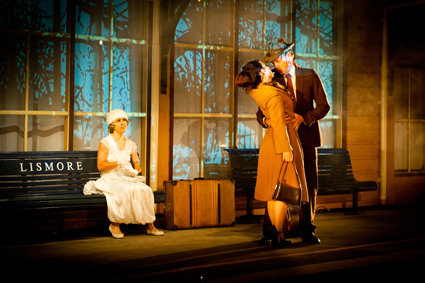ghost station
peter barclay: norpa, railway wonderland

Katia Molino, Neridah Waters, Jo Turner, Railway Wonderland
photo Grant MacIntyre
Katia Molino, Neridah Waters, Jo Turner, Railway Wonderland
A WONDERLAND USUALLY DESCRIBES A PLACE, REAL OR IMAGINARY, WHERE CURIOUS, SOMETIMES BEAUTIFUL THINGS HAPPEN. LEWIS CARROLL’S ALICE STORIES ARE THE CLASSICS OF A GENRE CHARACTERISED BY STRANGE JOURNEYS SHIFTING FROM THE REAL TO THE IMAGINARY, JUMPING ACROSS TIME AND DISPLAYING NOT A LITTLE NONSENSE.
Lismore railway station, the site for NORPA’s new collaboratively devised production Railway Wonderland is a very real place. Abandoned in 2004, a fading icon from another time, the station now sits idle except for a bus that drops by to ferry commuters onto the Sydney-Brisbane line in another town.
Approaching the station, there is a buzz. The audience is ushered across a walkway to seating above the rails. Looking back to the platform is like viewing the scene from a passing train. Through large windows, the waiting room is lit for the arrival of three present-day characters, there to catch the bus. Johnny Nasser’s George, a laid-back, 30-something hippie, is suitably familiar; so too, is Neridah Waters’ loud yet frail teen runaway Kelsie. Then there is Leonard, whose compulsive behaviours become a clever comic expository device, performed with studied physicality by Phillip Blackman. Later, they will be joined by George (Jo Kennedy), the not-so-talented winner of a local karaoke competition on his way to compete in Australia’s Got Talent. The action opens with Kelsie on her mobile anxiously searching for her boyfriend who never arrives. When Kelsie hangs up, a whistle blows and the lights cross-fade to reveal the spectral Ana, an old Italian woman dressed completely in white, sitting outside on the platform away from the rest. It is at this point that the station morphs and our wonderland journey begins.
Over the next 80 minutes, we are treated to a curious montage of incident, convention and style. Actors double roles. Their doubles sometimes seem to echo the experience of their contemporary characters. The performance jumps frenetically from comedy to melodrama, from song and dance to choreographed movement. Characterisation is broad, the tone irreverent. Several sequences are enacted as silent film; in others, romantic scenes from Hollywood’s golden years or Vietnam War footage form projected backdrops for the action. There are many magical moments. Two of my favourites: a tiny film projected on a suitcase and the metamorphosis of a luggage trolley into a steam train using snare drum and guitar. Present and past overlap in swiftly moving vignettes, incident piles on incident with arrivals and departures as the characters’ stories are revealed. At times, the shifts are almost anarchic; like Alice, sometimes we might wonder just where we are.
It is Ana who pulls together these disparate elements. A proxy bride of 16, she emigrated to Lismore in the 1940s; an epic journey to a hard place. Now Ana waits for a train to take her back home. We know the train will not come. Is she mad? Or is she, as her antique costume suggests, a spirit? Ironically, it is through Ana’s eyes that the action makes sense. Played with humour and verve by Katia Molino, Ana is central to this wonderland. She is our white rabbit. We feel her disappointment with her new husband. We see her estrangement from her son who moved away after returning from Vietnam. She transports us across time with the aid of a similarly costumed choir whose song medleys frame different eras. Her journey evokes a panorama from the romantic age of steam through to the present with Vietnam (and Nimbin’s infamous Aquarius Festival) as the turning point. It is to Ana the other characters reveal their secrets: Kelsie stole money from her mother for the tickets, George is gay but hasn’t come out to his mum, and Garry hasn’t seen his daughter for five years. Leonard has no secrets. When Leonard reveals Ana has escaped a nearby nursing home, that she often comes to the station to wait for the train that will not come, we are brought back to the pathos of a prosaic present. Ana and the abandoned station become one, their fates intertwined in the inevitability of time.
Despite the at times slapstick humour, the alienation of the migrant experience is at the heart of Railway Wonderland. I was reminded of writer and co-devisor Janis Balodis’ play Too Young for Ghosts (1985). In this light all the characters are like migrants. Railway Wonderland began its gestation two years ago with the sourcing of community stories about Lismore railway station. Since then it has undergone extensive collaborative development. Director Julian Louis and everyone involved have fashioned a memorable piece of community theatre, a celebration of the site itself and the passing of a bygone era.
NORPA: Railway Wonderland, concept, direction Julian Louis, devisor, writer Janis Balodis, devisors, performers, Philip Blackman, Katia Molino, Johnny Nasser, Jo Turner, Neridah Waters, composer, musical director Michael Askill, musician Shenton Gregory, choreographer Emma Saunders, designer William Kutana, lighting designer Richard Morrod, video designer Salvador Castro, dramaturg Deborah Pollard, creative producer Marisa Snow, NORPA Generator Creative Development Program; the former Lismore Railway Station, NSW, March 27-31
RealTime issue #109 June-July 2012 pg. 29






